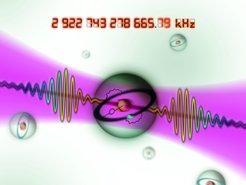Foundations of Quantum Physics
Leader: Prof Dr Thomas Udem
Often discrepancies between theory and experiment led to advancements in physics. This is also how quantum electrodynamics, or QED in short, emerged. Today, it is the most precise theory in physics and served as a blueprint for all subsequent field theories. However, as is known from cosmological observations, unknown physics beyond the so-called standard model must exist. It probably lies hidden where no one has been looking, e.g. at very high energies or extreme precision. Spectroscopy of atomic hydrogen and similar systems is almost indispensable to make progress at the so-called precision frontier. Because the simplicity of their structure with just one electron is the key to discovering new fundamental physics

Wanting to test quantum electrodynamics means checking the consistency of the parameters on which the theory is based in as many distinct measurements as possible. Spectroscopic data also provide the input for determining the best values for the fundamental constants. The greatest leverage in determining the Rydberg constant currently lies in the 1S-3S transition frequency, which Thomas Udem's group aims to improve as part of this proposal.
A second apparatus provides a cold beam of atomic hydrogen and deuterium in the metastable 2S state. This will be applied in a series of measurements that use the 2S state as the ground state. As another step, the physicists plan to develop a method for trapping atomic hydrogen in an optical dipole trap in which they can lock the atoms in such a way that their excitation can be measured with great precision. Trapped hydrogen atoms can be used for a new type of optical atomic clock whose frequency is calculable using QED. This would allow the second to be defined in terms of fundamental constants. Such a procedure opens up advantages for the realisation of measurement units and is already used for all other units.

"The ERC Advanced Grant is very important for us, because it allows us to continue our research on hydrogen. New physics beyond the standard model may be lurking in the decimal places and we can only get to it with ultra-precise spectroscopic measurements," says Thomas Udem, head of the research group.
Thomas Udem's group currently consists of two postdoctoral researchers, one doctoral student, two Master's students and two interns. For the new five-year H-SPECTR project, the group is looking to fill additional positions - at least two doctoral positions and one postdoctoral position. Applicants can send their documents directly to Thomas Udem at thomas.udem@mpq.mpg.de.

